Artificial intelligence (AI) is rapidly transforming many aspects of our lives, and the field of AI content detection is no exception. AI-generated material, such as text, documents, photos, and videos, may be recognized using AI content detection techniques. By assisting in the fight against the spread of disinformation and fake news, as well as by safeguarding people’s security and privacy, this technology can completely transform how people interact with and consume information online.
This article will examine the various applications of AI content detection as well as the difficulties and possibilities that this technology offers. We will also talk about the future of AI content detection and how it will change society in the following years.
AI Content Detection for Text, Documents, Images, and Videos
AI content detection can be used in various ways for text, documents, images, and videos. For example, AI content detectors can be used to:
- Recognize AI-generated text in books, blogs, social media postings, and other text-based material. This can be beneficial for identifying and eliminating AI-generated spam and disinformation and verifying the validity of academic papers and other intellectual works.
- Recognize AI-generated documents, including fake receipts, resumes, and cover letters. This can help businesses and organizations defend themselves from fraud and other hazards.
Why is AI content detection important?
The significance of AI content detection cannot be underestimated. First, it can aid in halting the spread of fake and misleading information. Social media postings, false news stories, and other intentionally misleading information may be created through artificial intelligence (AI) generated content. We can recognize and delete this content from the web through AI content detection.
Second, AI content detection can aid in enhancing the standard of online content. The quality of AI-generated material is frequently subpar, and it can be challenging to tell apart from the human-produced content. We can find and delete poor-quality AI-generated information from the internet by employing AI content detection, and we can contribute to raising the standard of online content as a whole.
How do AI content detectors work?
AI content detectors use a variety of techniques to identify AI-generated. One common approach is to use machine learning algorithms to analyse the statistical properties of text. For example, AI content detectors may look for patterns in using certain words or phrases or look for ways in which sentences are structured.
Another common technique is to use natural language processing to analyse the semantic meaning of text. For example, AI content detectors may look for patterns in how concepts are related or how information is presented.
Best AI content Detectors
1. Winston AI
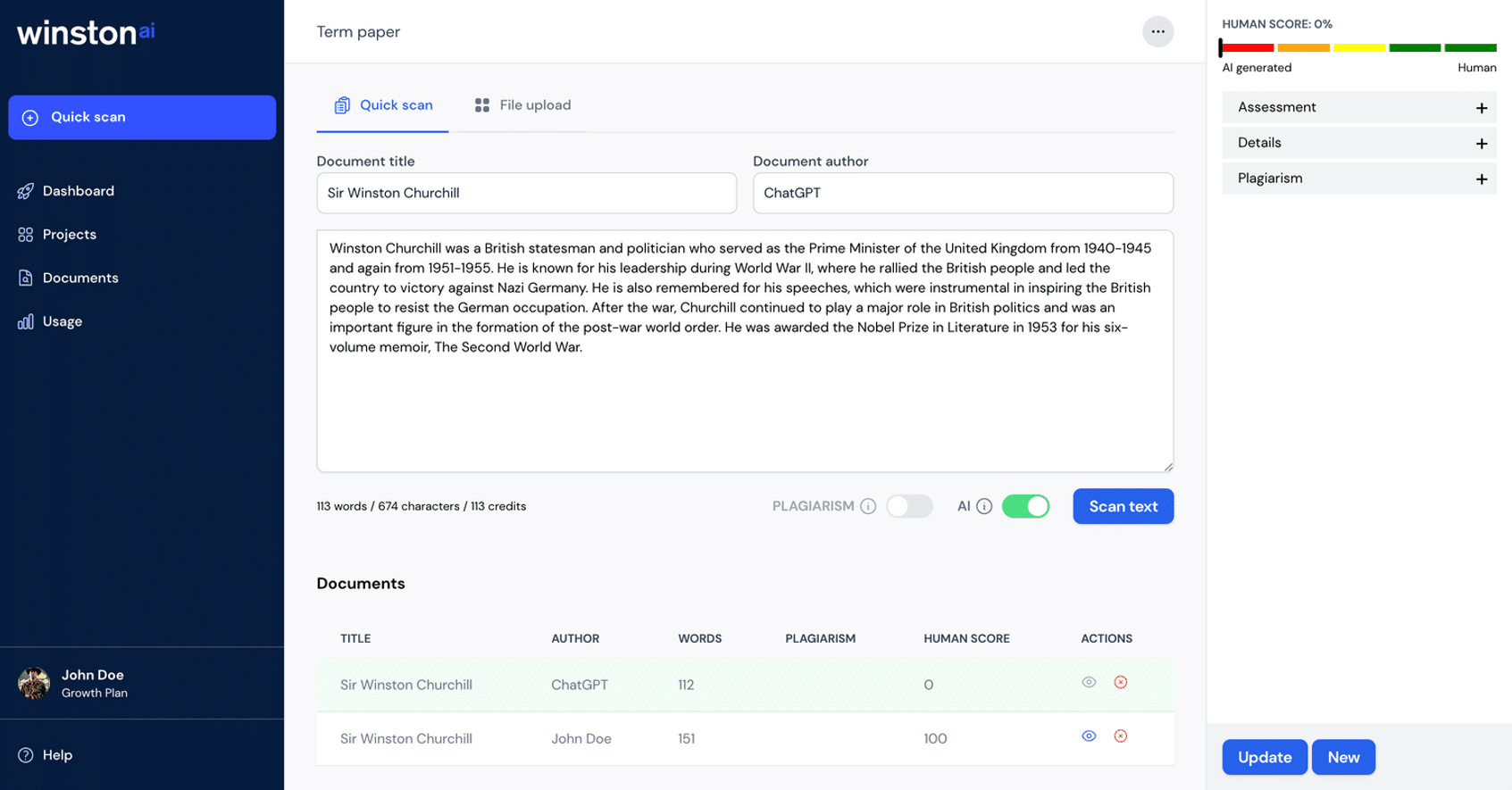
Pros:
- Very accurate at detecting AI-generated content, even from the latest models like ChatGPT and Bard.
- Easy to use, with a clean and simple interface.
- Supports a variety of file types, including text, images, and videos.
- Its model is updated to keep up with every notable LLM update.
- Offers a variety of features, including plagiarism detection, readability analysis, and tone detection.
- It boasts itself as the only AI detector with a 99.6% accuracy rate.
- Multilingual support in French and German is available.
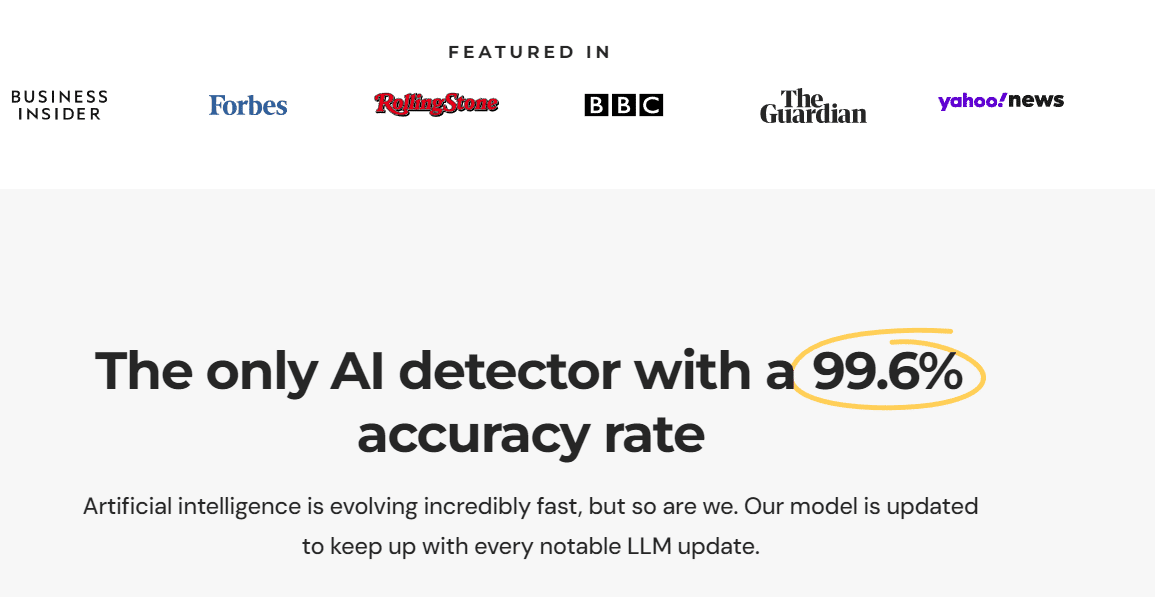
Cons:
- The free plan only supports a 2000-word scan.
- Limited to 80,000 words scanned per month on the essential plan.
- It can be slow to process large files.
Pricing:

Some of its other features are:
- Winston AI uses various techniques to detect AI-generated content, including statistical analysis, pattern recognition, and machine learning.
- Winston AI can detect AI-generated content even if mixed with human-written content.
- Plagiarism detection: Winston AI can check your content for plagiarism against a database of over 100 billion web pages.
- Readability analysis: Winston AI can analyze your content for readability and suggest improvements.
Overall, Winston AI is an all-around effective and trustworthy AI content detector that is simple to use and reasonably priced. It is a beautiful option for companies and people who need to be able to precisely and rapidly recognize information created by AI.
2.Originality.ai
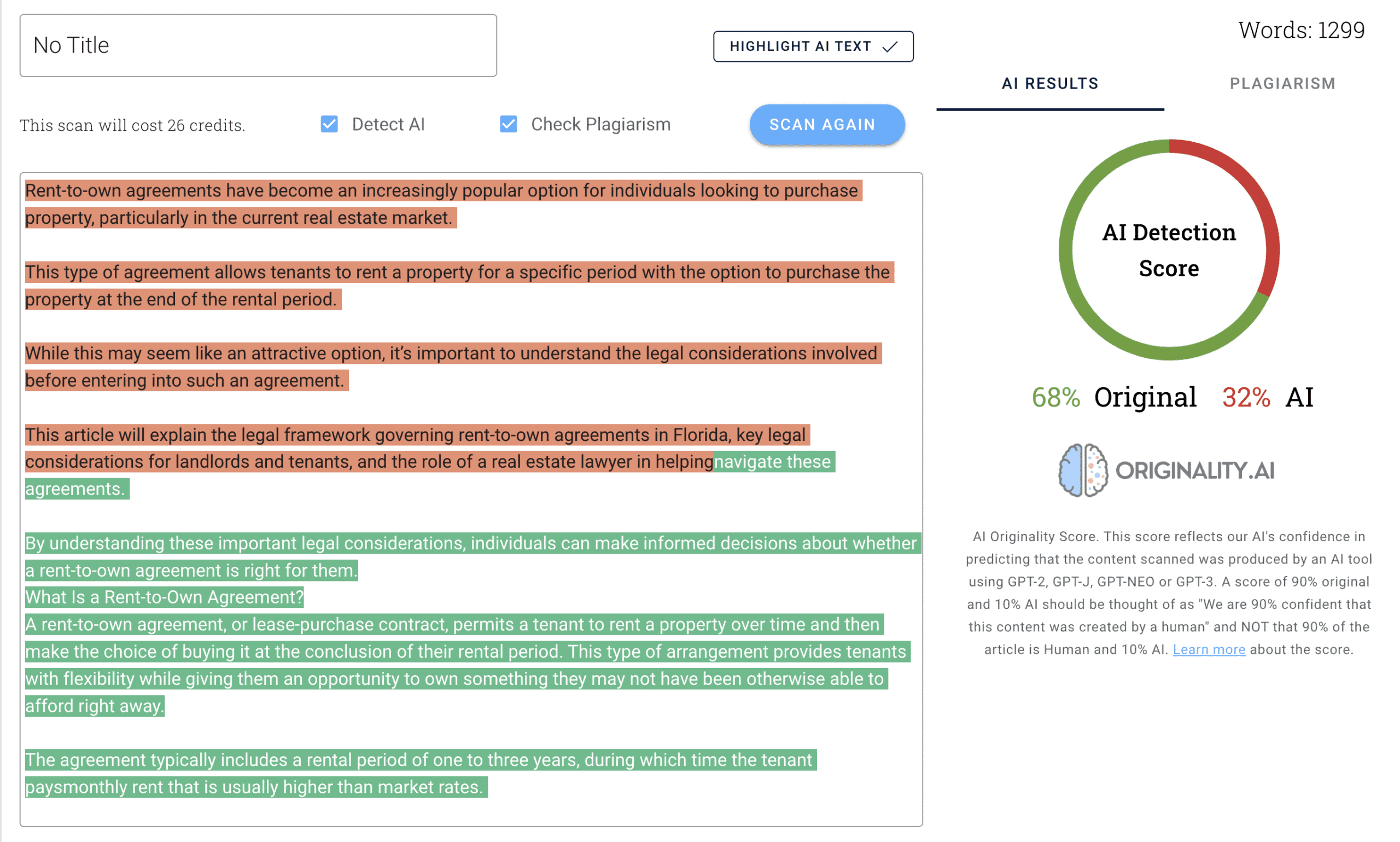
Pros:
- Very accurate at detecting AI-generated content, even from the latest models like the most accurate Chat GPT, Bard, Paraphrasing, and GPT-4 AI.
- Checker explicitly built for content marketers and SEOs.
- Easy to use, with a clean and straightforward interface.
- Supports various file types, including text, images, and videos.
- Offers a variety of features, including plagiarism detection, readability analysis, and tone detection.
- The impressive “Readability” feature ensures the developer produces high-quality content to rank better on Google and other Search Engines.
- Chrome extension available.
- Multiple languages and cultural nuance recognition


Cons:
- No free plan.
- Limited to 50,000 characters per month on the basic plan.
- Can be slow to process large files.
Pricing:
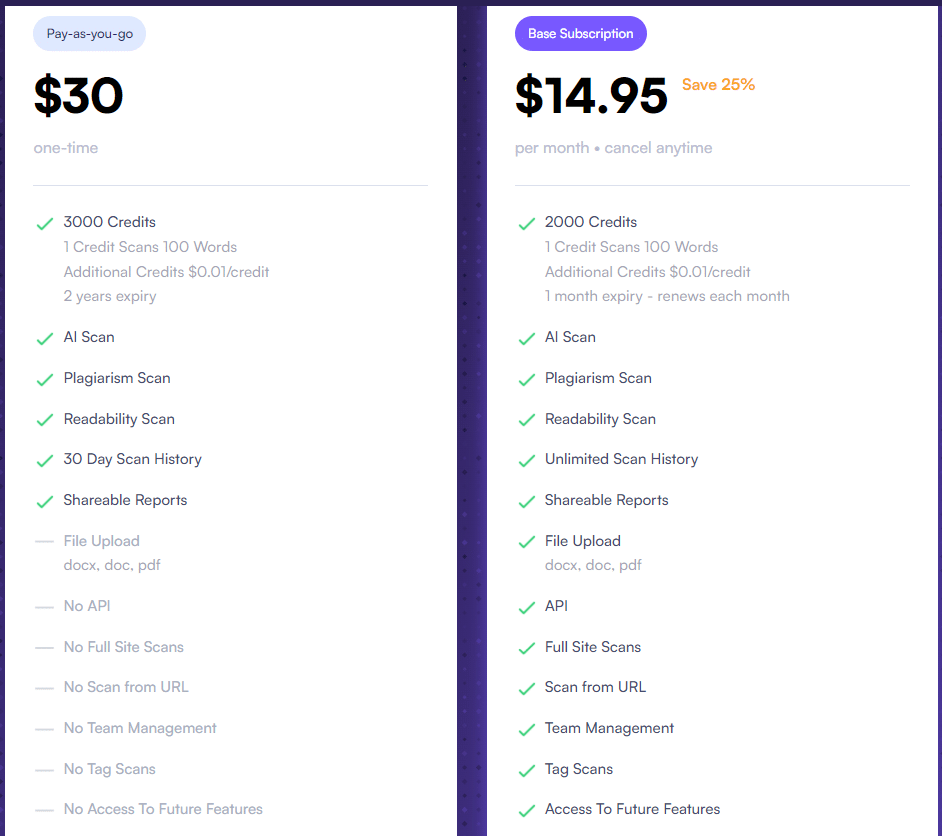
Some of its other features are:
- Originality.ai uses various techniques to detect AI-generated content, including statistical analysis, pattern recognition, and machine learning.
- Originality.ai can detect AI-generated content even if it is mixed with human-written content.
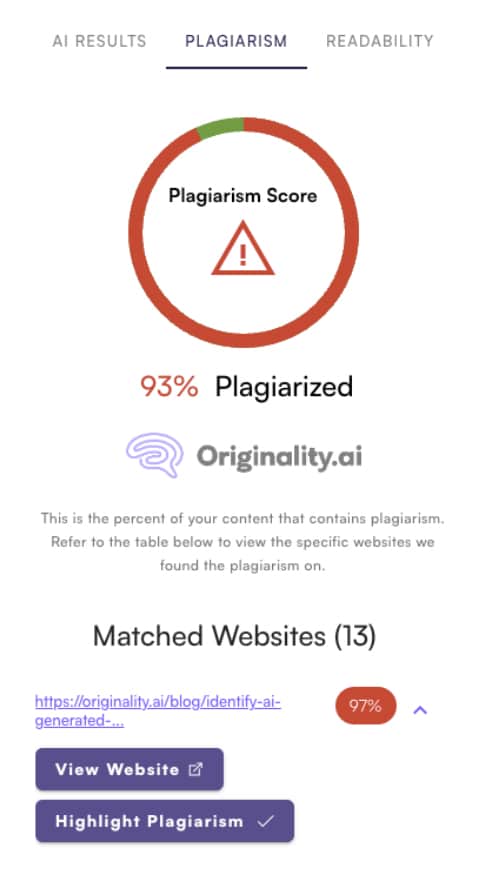
- Bulk Site Scan – It lets you Scan your entire site to understand the risk of your site being included in future AI updates from Google.
-
Protect Your Site – It makes your site future-proof from the potential for Google penalizing AI content and only publishing content you know the true Originality of.
Overall, Originality.ai is an impressive AI detector. It is a robust and reliable AI content detector that is easy to use and affordable. It is recommended for anyone needing to quickly and accurately identify AI-generated content.
3. GPTZero
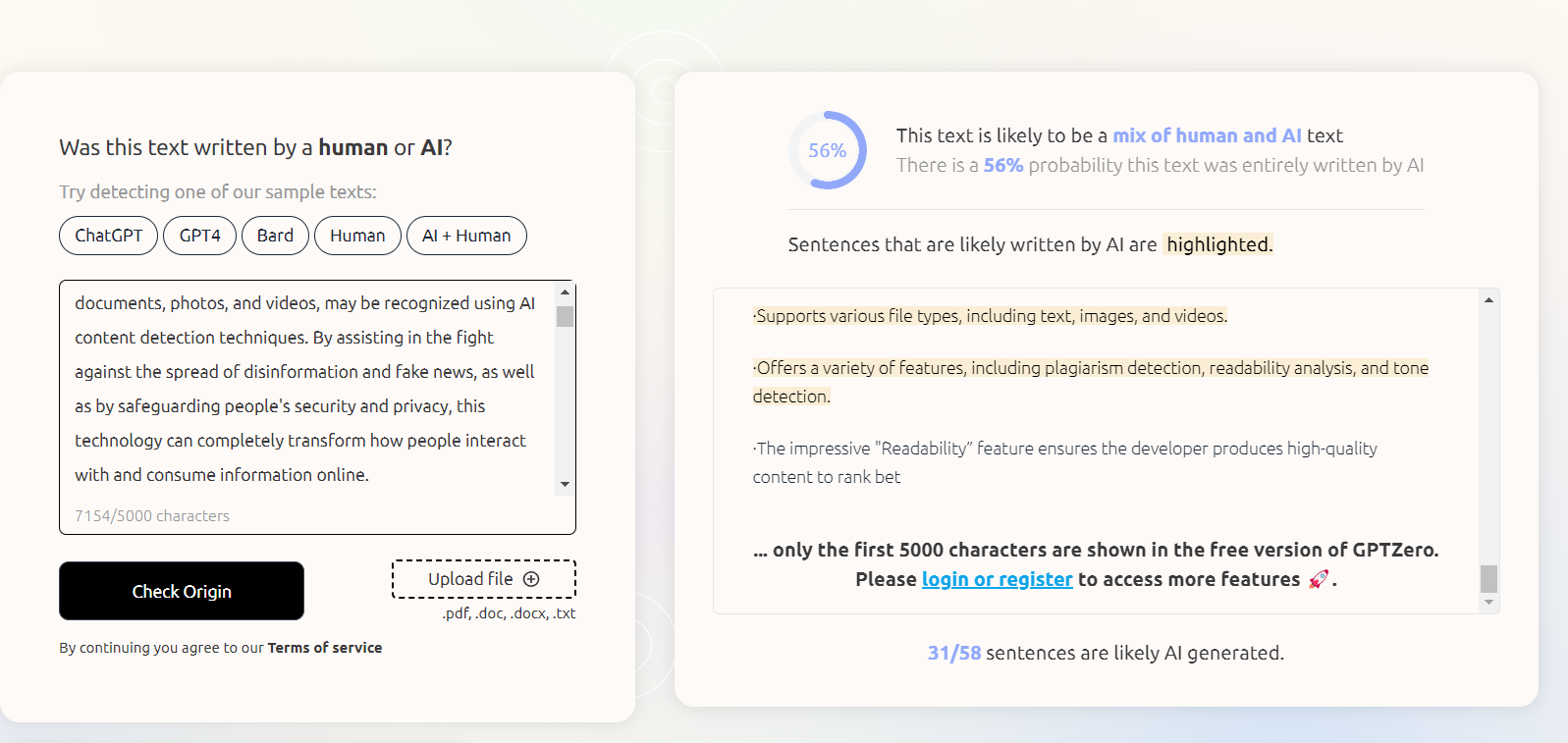
Pros:
- Free to use.
- Supports both code and text.
- Support simultaneous upload of multiple files.

- Provide API access for organizations.
- Offers information on the text’s bloat and complication as well as its chances of being created by AI.
- Provides a Chrome extension and Microsoft Word Integration.
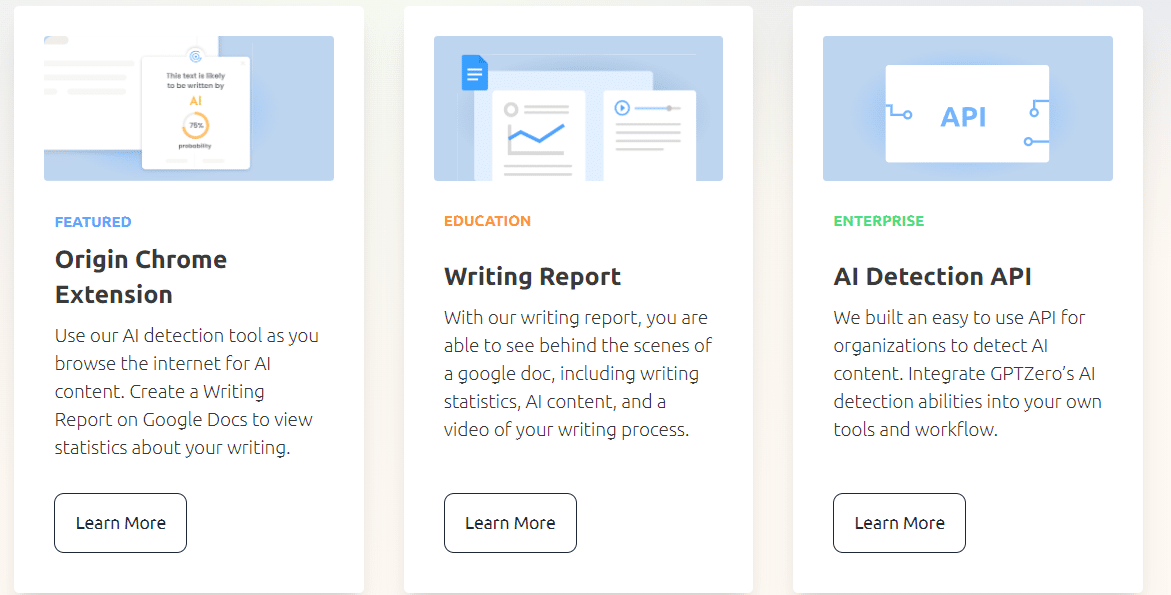
-
Has a solid track record of identifying material produced by AI using a range of models, such as Chat GPT, GPT 3, GPT 4, Bard, and LLaMa models.


Cons:
- Not as accurate as some paid AI content detectors.
- Can be fooled by highly polished AI-generated content.
- Does not provide a detailed breakdown of the reasons why it believes the content is AI-generated.
Some of its other features are
- GPTZero use a range of strategies, including statistical analysis, pattern recognition, and machine learning, to find information produced by AI.
- Even when combined with human-written information, AI-generated content may be found with GPTZero..
It is a free and straightforward AI content detector that may reasonably recognise AI-generated material. Anyone who needs to identify AI-generated content but cannot afford to pay for a subscription-based service is advised to use it.
GPTZero is a free AI content detector, while Winston AI and Originality.ai are paid AI content detectors. GPTZero is not as accurate as Winston AI or Originality.ai, but it is still a good option for students, educators, and other individuals who need to be able to identify AI-generated content for free.
4. Content at Scale AI Text Detector
Pros:
- Free version is good to use.
- Easy to use, with a simple interface.
- Supports text and code.
- 98% Accurate AI Checker with training on online blogs, wikipedia, essays,
- Provides a score indicating the likelihood of AI-generated content.
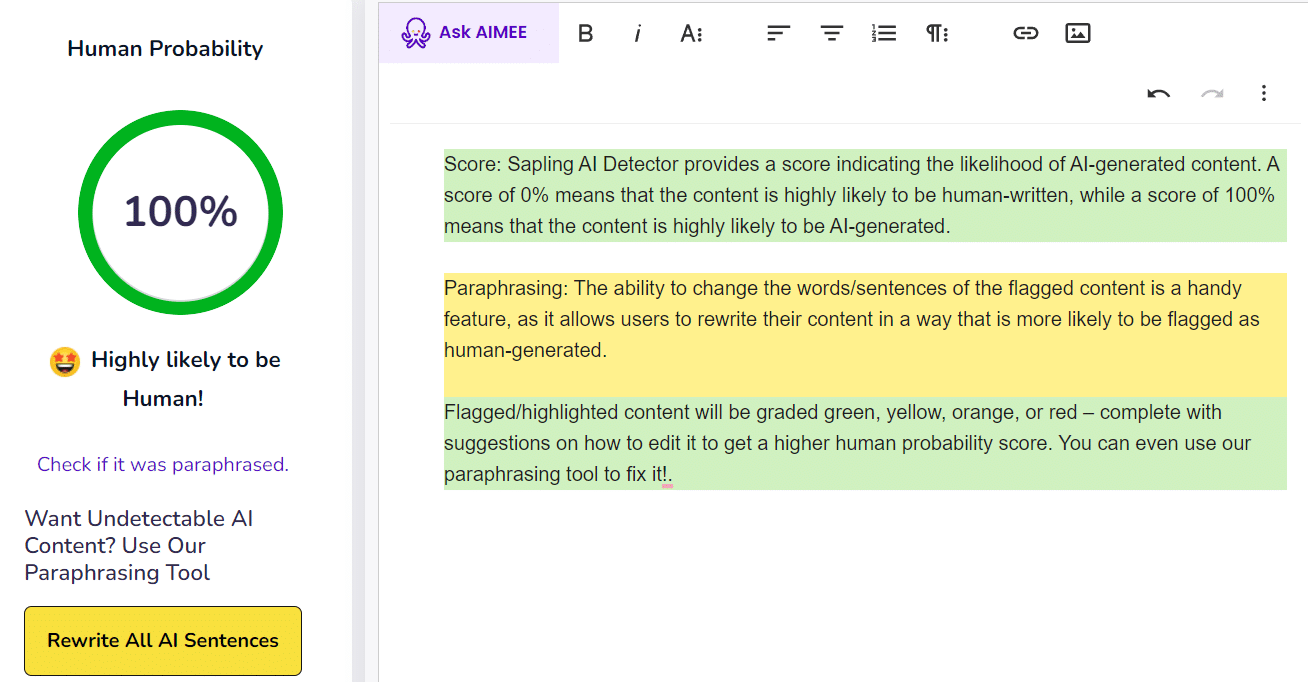
- Highlights specific parts of the text that are likely to be AI-generated.
- Provides Agency Adaptation Action Plan.
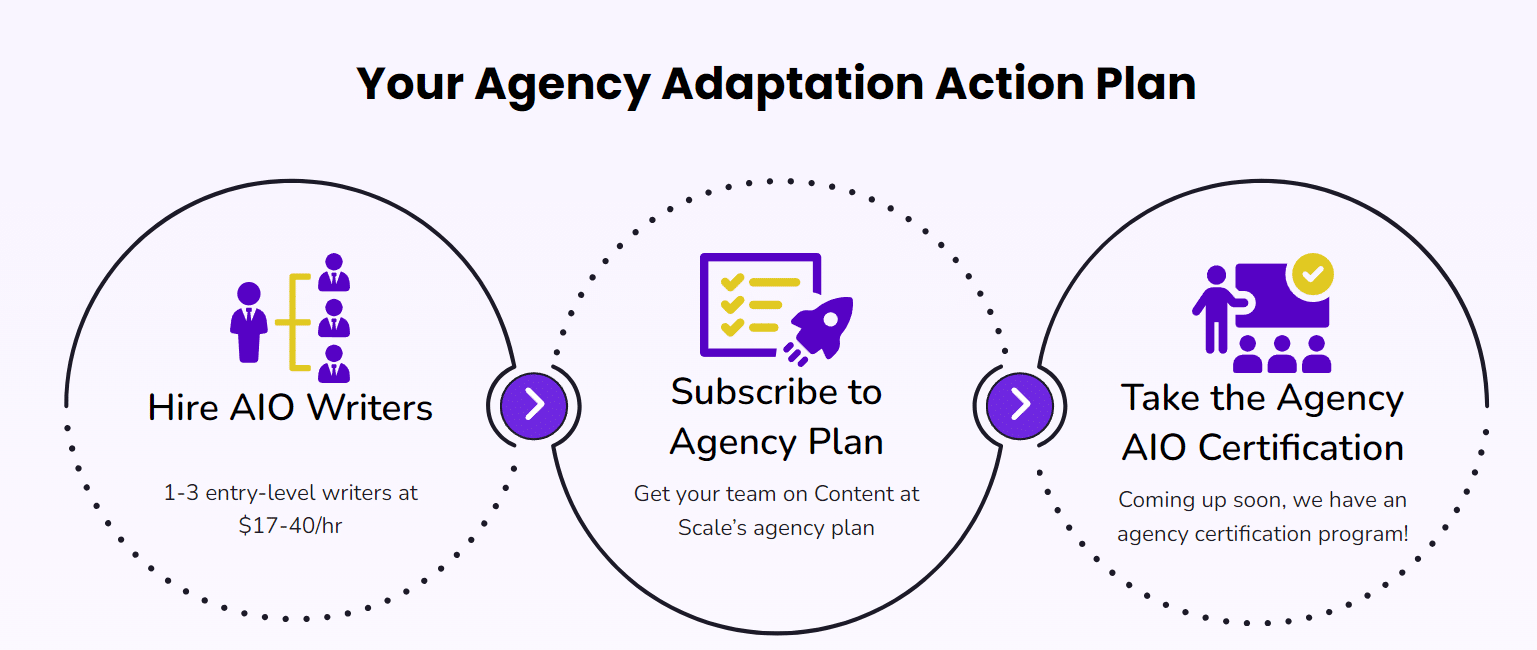
- A free AI checker is usually hit or miss. Meanwhile, Content at Scale’s AI Detector can detect content generated by ChatGPT, GPT4, GPT3, Bard, Claude, and other LLMs.
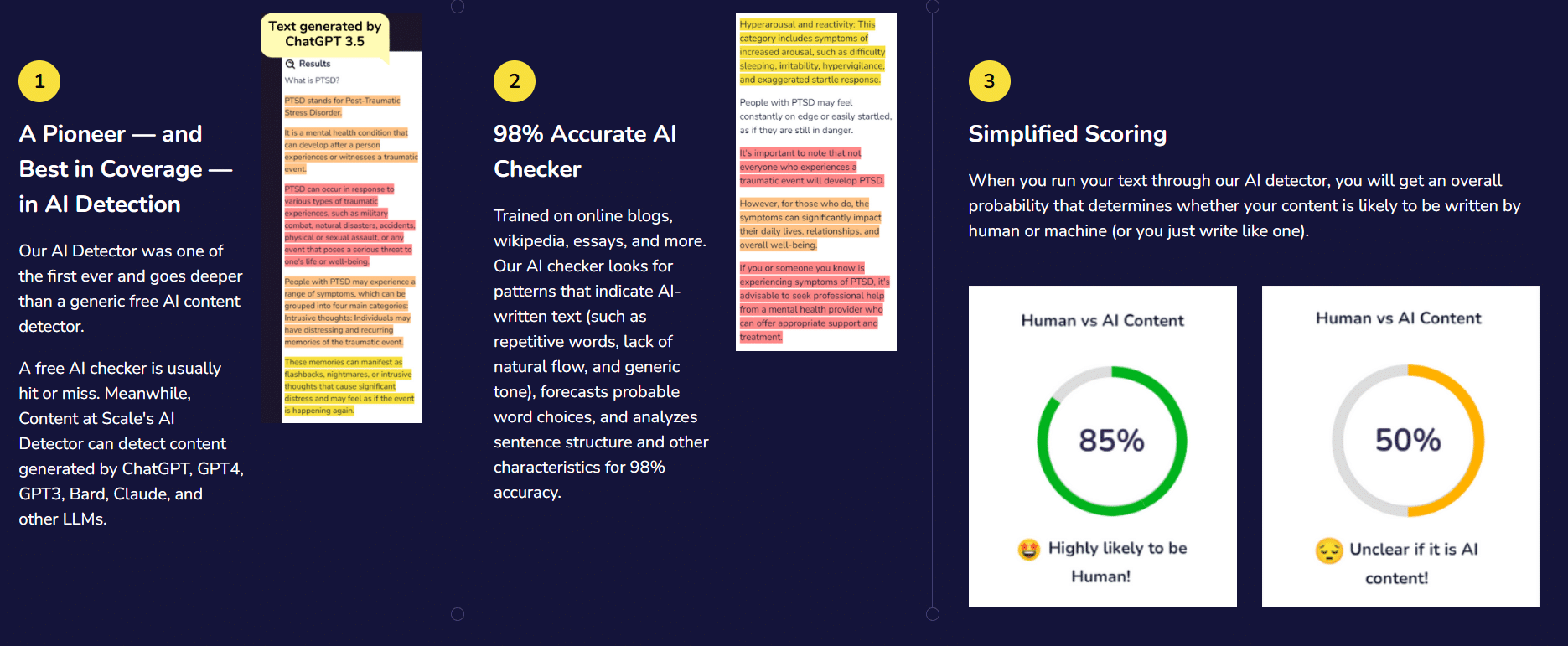
Cons:
- It’s less accurate than some paid AI content detectors.
- Can be fooled by highly polished AI-generated content.
- It doesn’t explain why it believes the content is AI-generated.
- The free version has limited features, the paid has more features like Unlimited AI Detection + Paraphrase Analysis, Undetectable Rewrite, Bulk Undetectable Rewrites, Unlimited Image AI Detection, Scan by URL, Premium Editor and Export to Word/Doc/HTML.
Pricing:
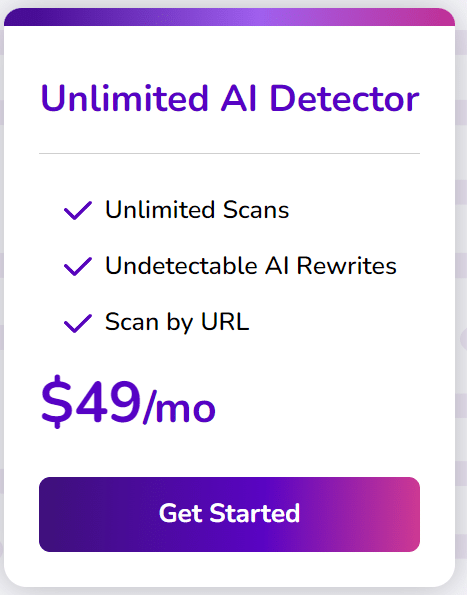
Some of its other features are
-
Paraphrasing: The ability to change the words/sentences of the flagged content is a particularly useful feature, as it allows users to rewrite their content in a way that is more likely to be flagged as human-generated.
- Flagged/highlighted content will be graded green, yellow, orange, or red – complete with suggestions on how to edit it to get a higher human probability score. You can even use our paraphrasing tool to fix it!.
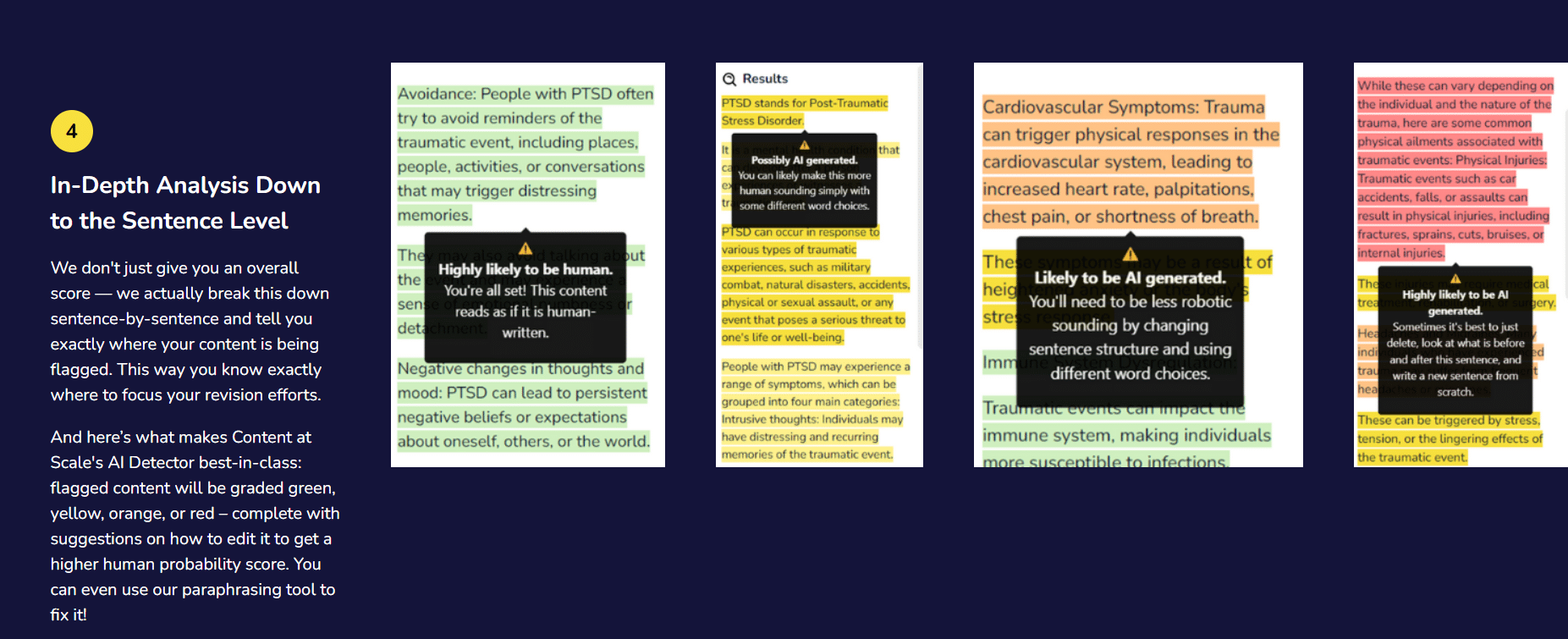
5. Sapling.ai
Pros:
- This free AI writing detector outputs the probability that a text is AI-generated by a model such as ChatGPT or Bard.
- Easy to use, with a simple interface.
- Offers API and chrome extension.

- It boasts that it catches more than 97% of AI-generated texts while keeping false positives below 3%.
- Offers paid and enterprise versions as well at reasonable prices.
- Provides a score indicating the likelihood of AI-generated content.
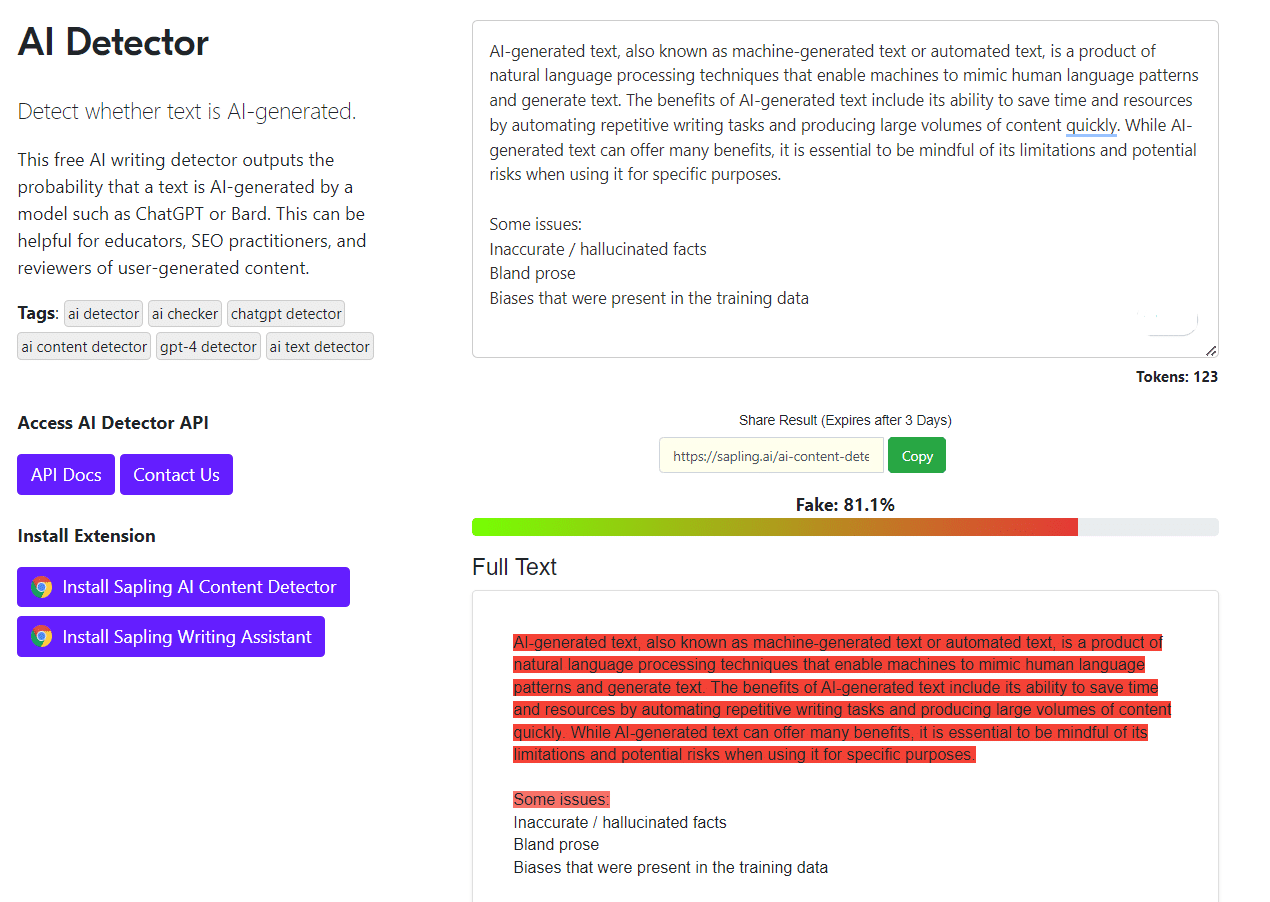
- Highlights specific parts of the text that are likely to be AI-generated.
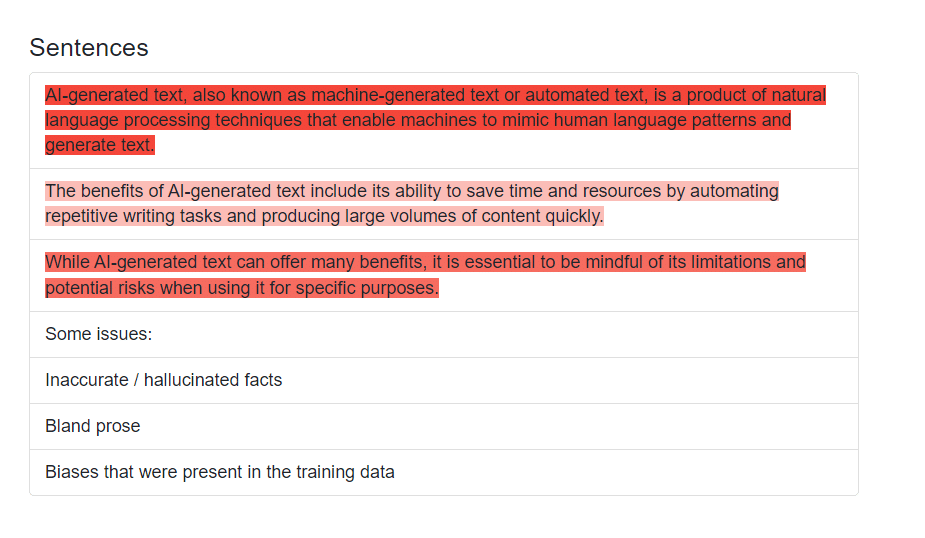
Cons:
- Can be duped by highly polished AI-generated content.
- Does not provide a detailed explanation of why it believes the content is AI-generated.
Pricing:
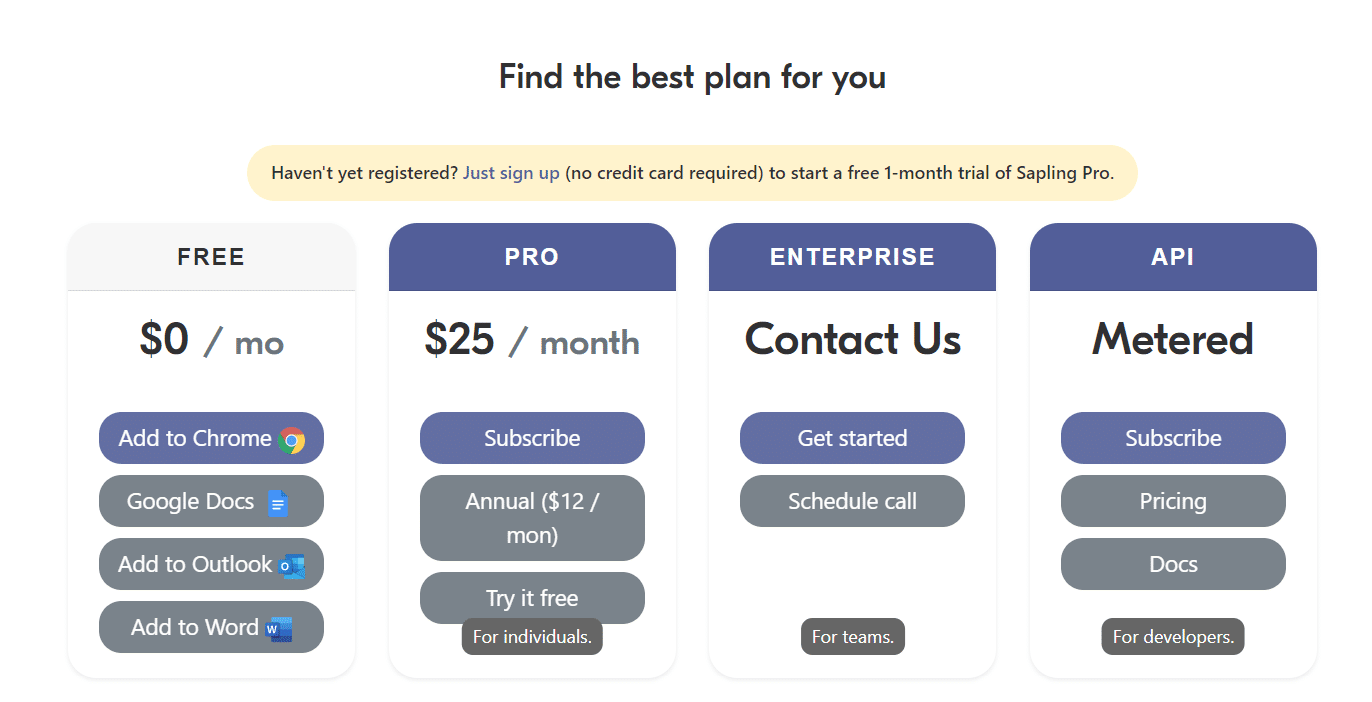
Some of its other features are
- Sapling AI Detector uses a variety of techniques to detect AI-generated content, including statistical analysis, pattern recognition, and machine learning.
- Sapling’s autocomplete solution provides deep learning-powered autocomplete suggestions across various CRM and messaging platforms.
- Offer other products to check Grammar like Grammarly as well.
- Sapling’s Suggest solution recommends live chat responses across support and sales platforms, resulting in faster resolutions.
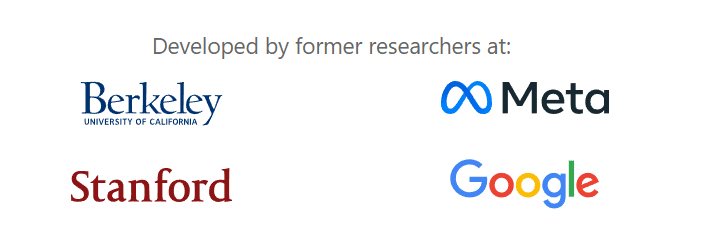
Sapling AI Detector is a good option for students, educators, and other individuals who need to be able to identify AI-generated content, but who cannot afford to pay for a subscription-based service.
6. Writer.com AI Content Detector
Pros:
- Easy to use, with a very simple interface.
- Supports text and code.
- Provides AI content detection on URLs as well.
- Provides a score indicating the likelihood of AI-generated content.

Cons:
- Free to use, up to 1,500 characters only.
- Not as accurate as some free/paid AI content detectors.
- Can be duped by highly polished AI-generated content.
- Does not provide a detailed explanation of why it believes the content is AI-generated.
- Does not highlight specific parts of the text that are likely to be AI-generated.
- Focuses on a wide range of products and not just AI content detector.
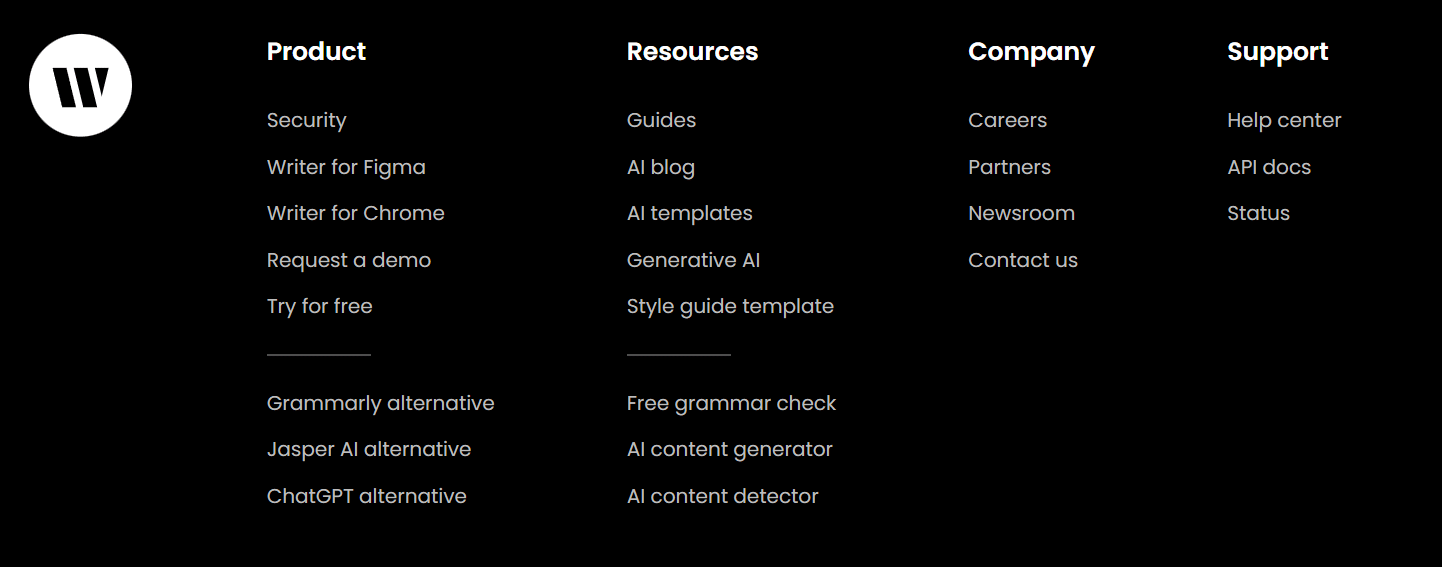
7. Copyleaks
Pros:
- Very accurate at detecting AI-generated content.
- Easy to use, with a clean and simple interface.
- Supports a variety of file types, including text, images, and videos.
- Offers a variety of features, including plagiarism detection, readability analysis, and tone detection.
- Affordable pricing plans.
- It boasts that with 99.1% accuracy and full model coverage that includes GPT-4 and Bard, Copyleaks AI Content Detector is the market’s most comprehensive solution.
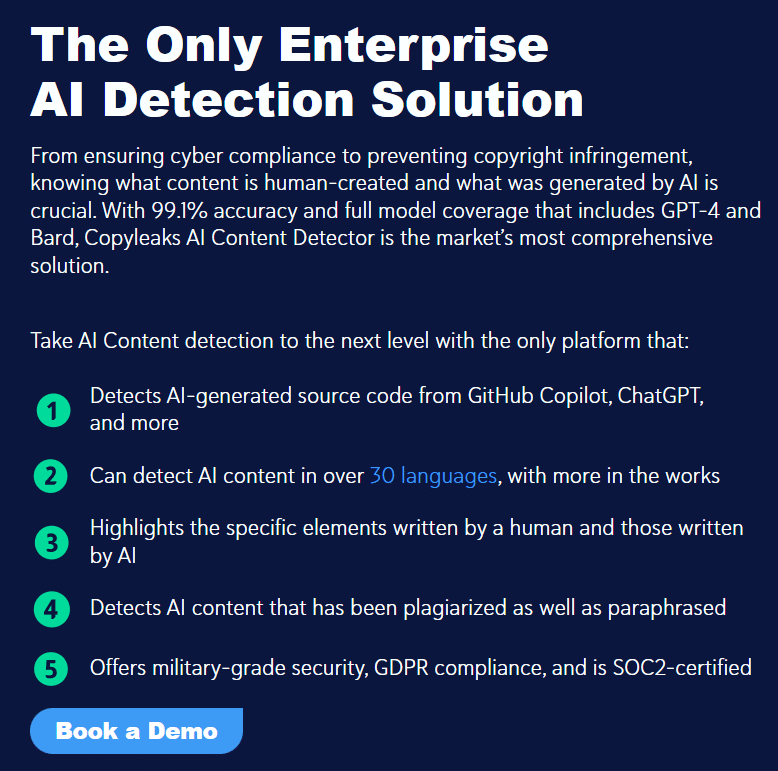
- Provides chrome extension, API and LMS integration.
- Detects AI content that has been plagiarized as well as paraphrased.
- Offers military-grade security, GDPR compliance, and is SOC2-certified.
- Detection in over 30 languages.
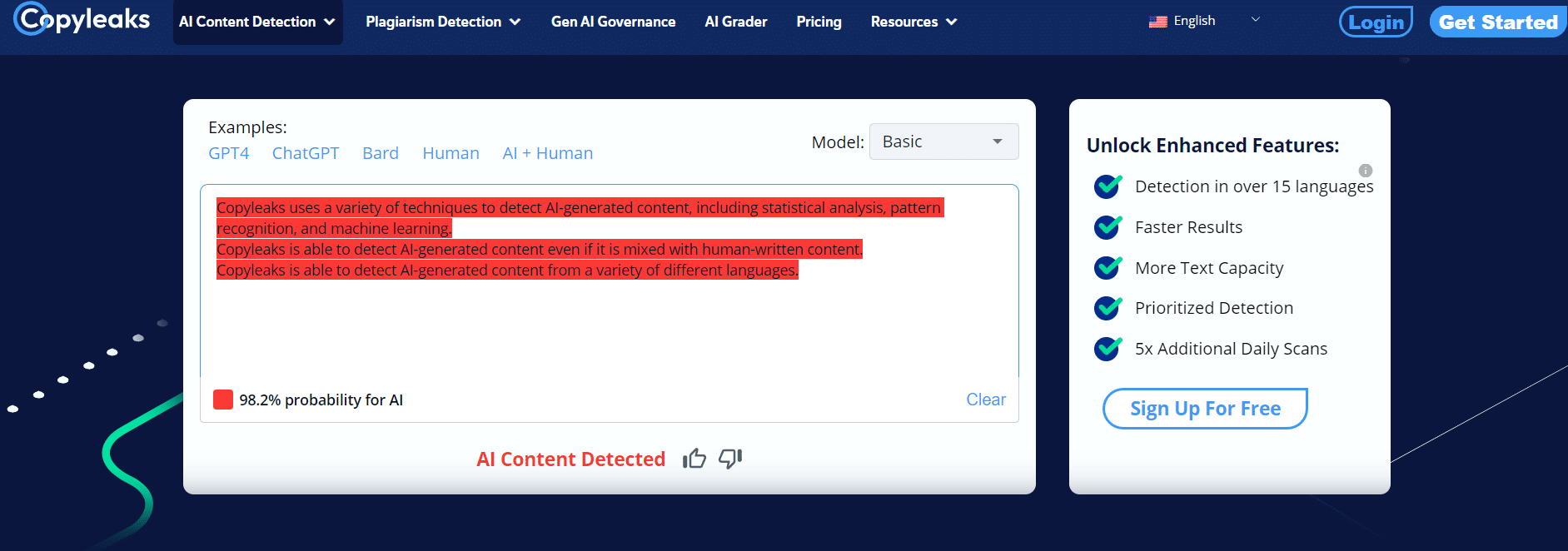

Cons:
- No free plan.
- Limited to 100,000 words per month on the basic plan.
- Can be slow to process large files.
Pricing:
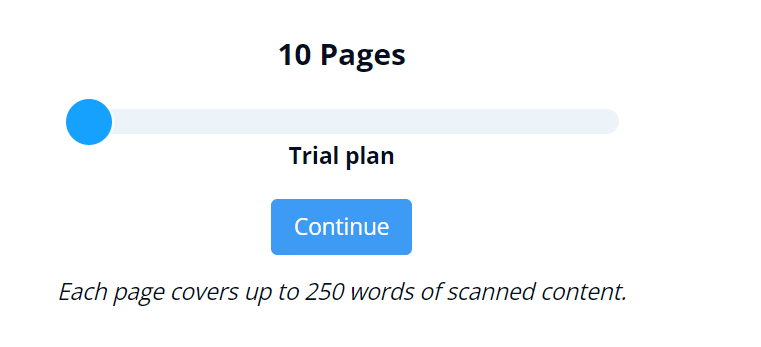
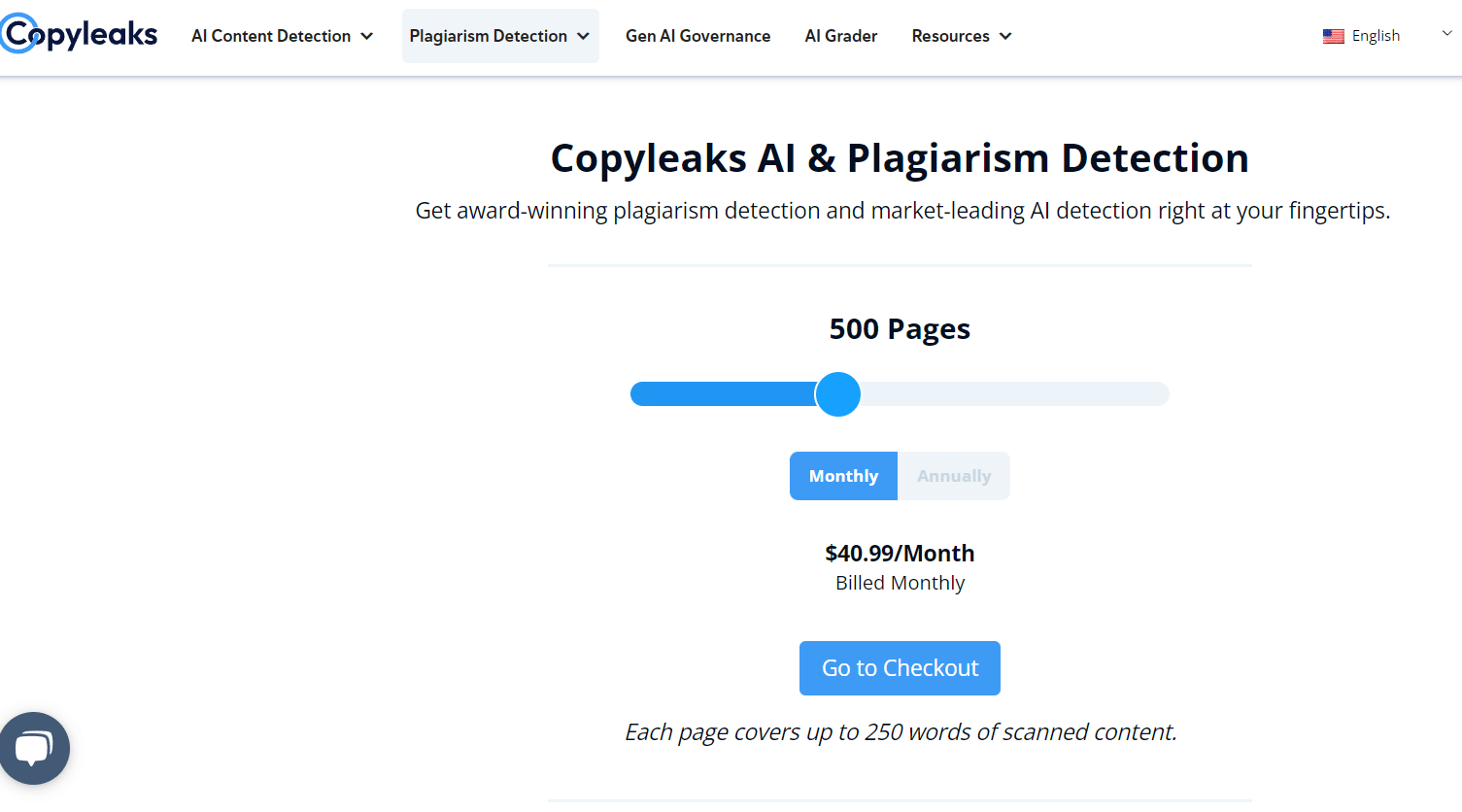
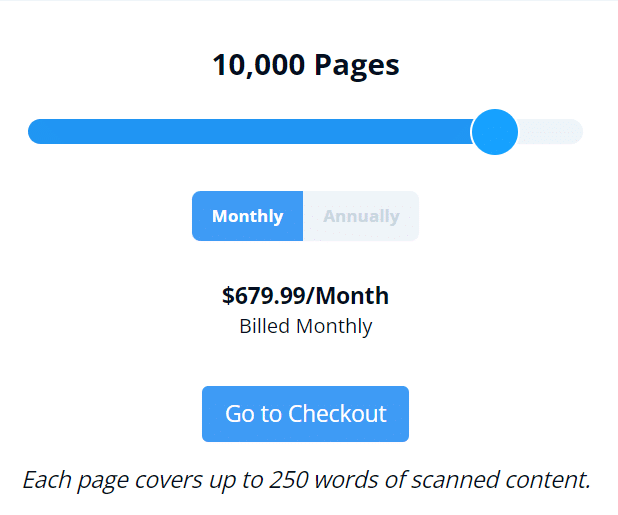
Some of its other features are
- Copyleaks uses a variety of techniques to detect AI-generated content, including statistical analysis, pattern recognition, and machine learning.
- Copyleaks is constantly being updated to keep up with the latest advances in AI content generation.
- Plagiarism detection: Copyleaks can check your content for plagiarism against a database of over 100 billion web pages.
Copyleaks is still a good option for businesses and individuals who need to be able to identify AI-generated content quickly and accurately and can afford to pay for a subscription.
8. CrossPlag AI Content Detector
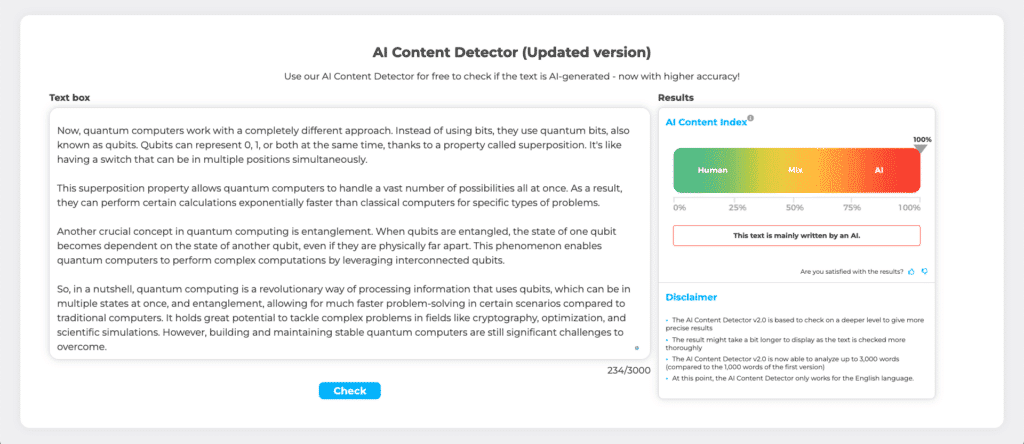
Pros:
- Easy to use, with a simple interface.
- Supports text and code.
- Provides a score indicating the likelihood of AI-generated content.
- Reasonable price and institutes version also available.
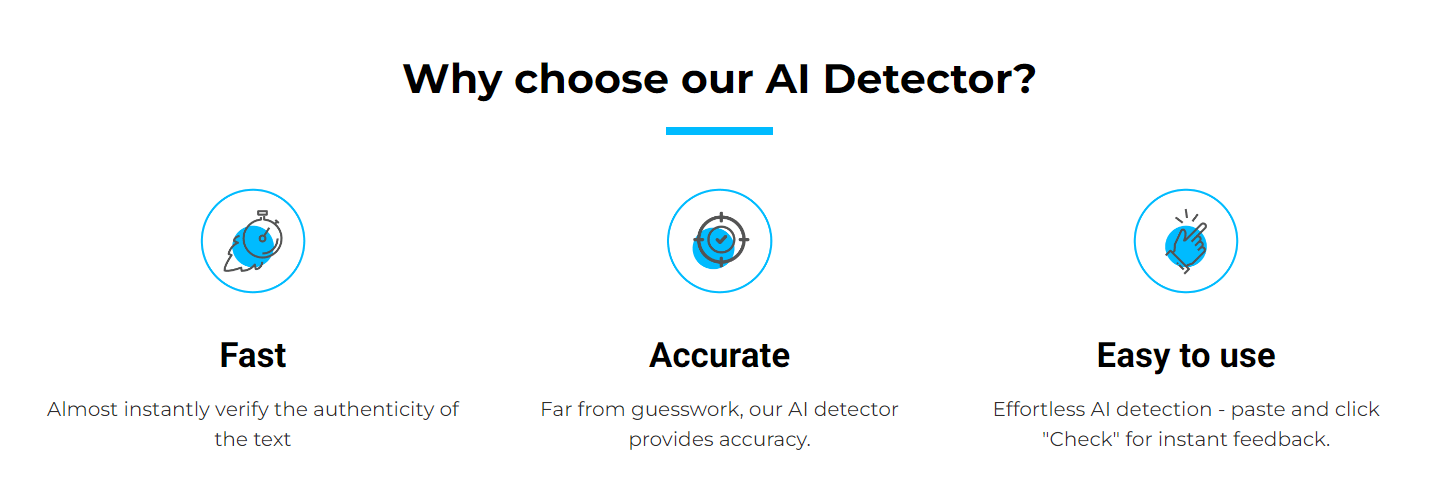
Cons:
- Not as accurate as some paid AI content detectors.
- Can be duped by highly polished AI-generated content.
- Does not provide a detailed explanation of why it believes the content is AI-generated.
- The AI Content Detector v2.0 is able to analyze up to 3,000 words only.
- Does not highlight specific parts of the text that are likely to be AI-generated.
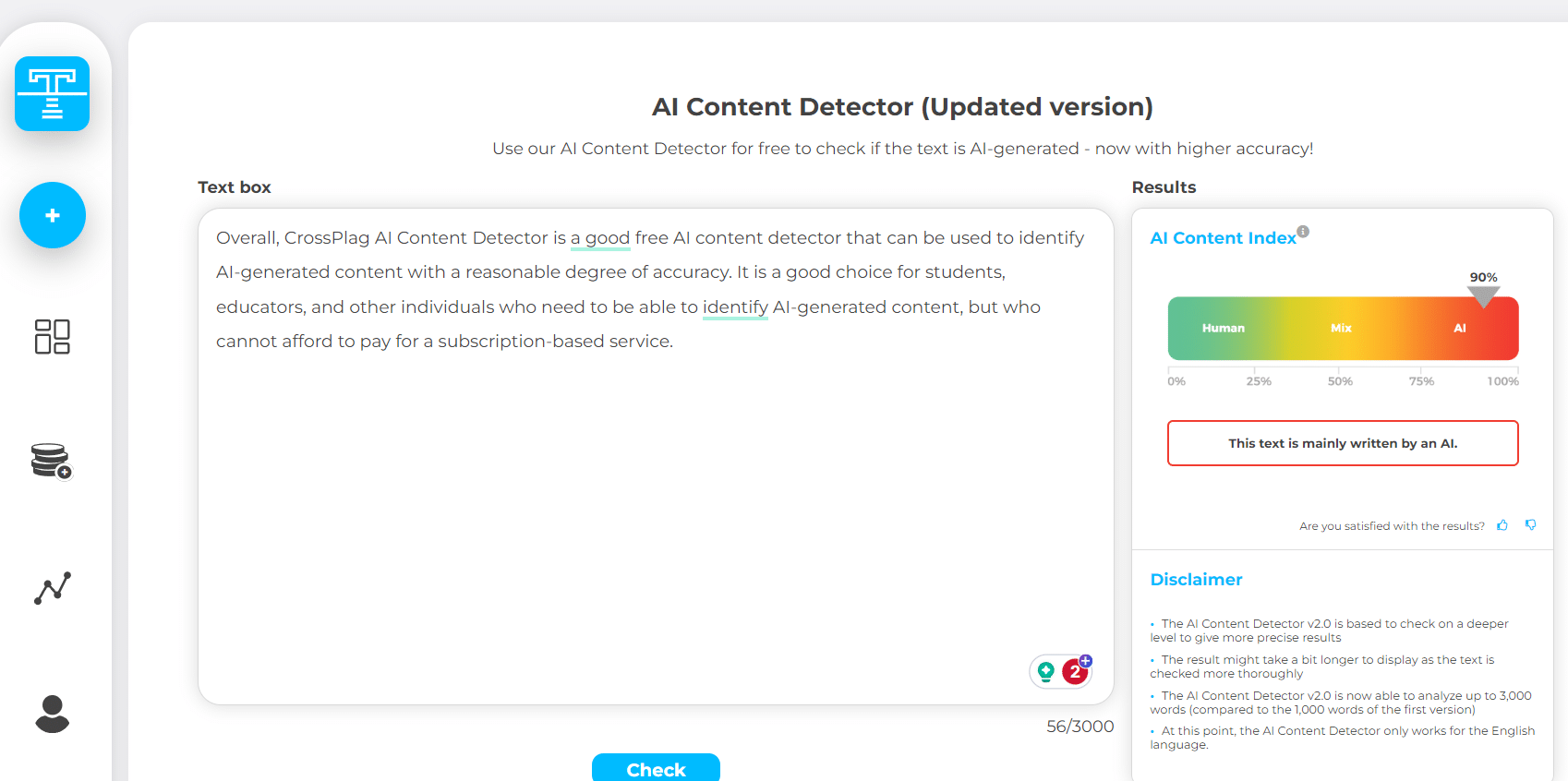
Pricing:
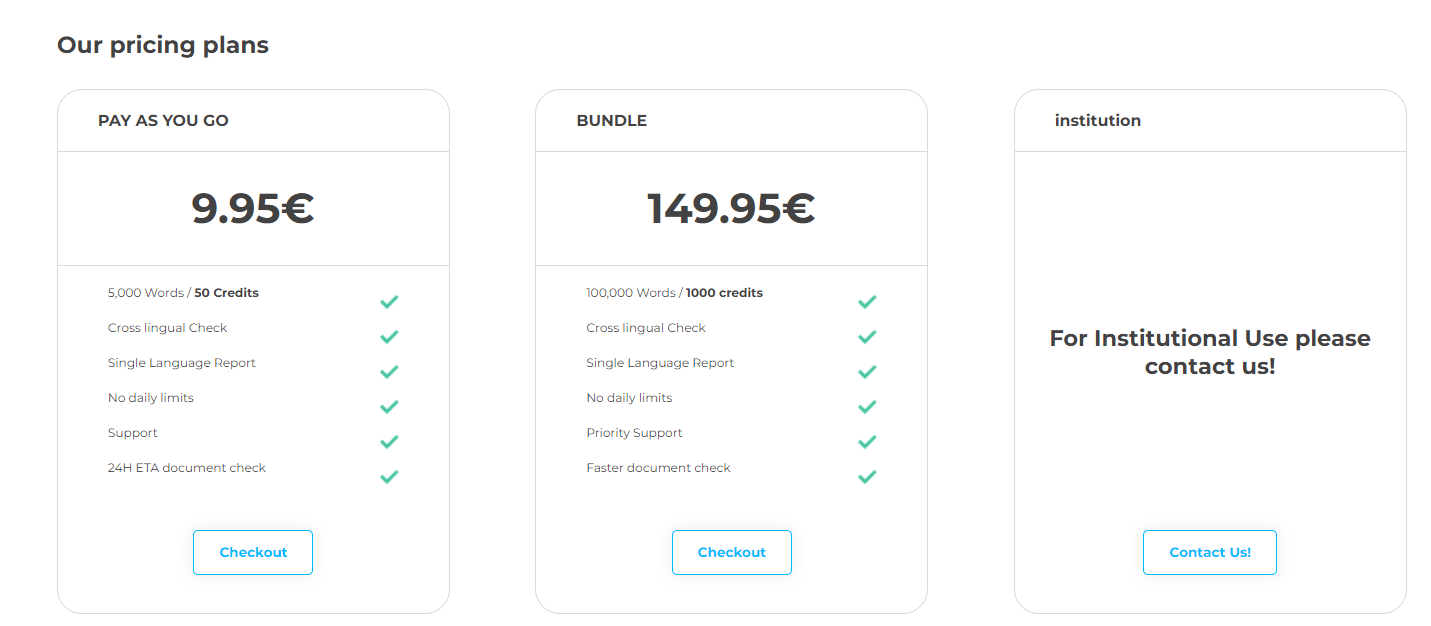
9. GPT-2 Output Detector (Hugging Face)
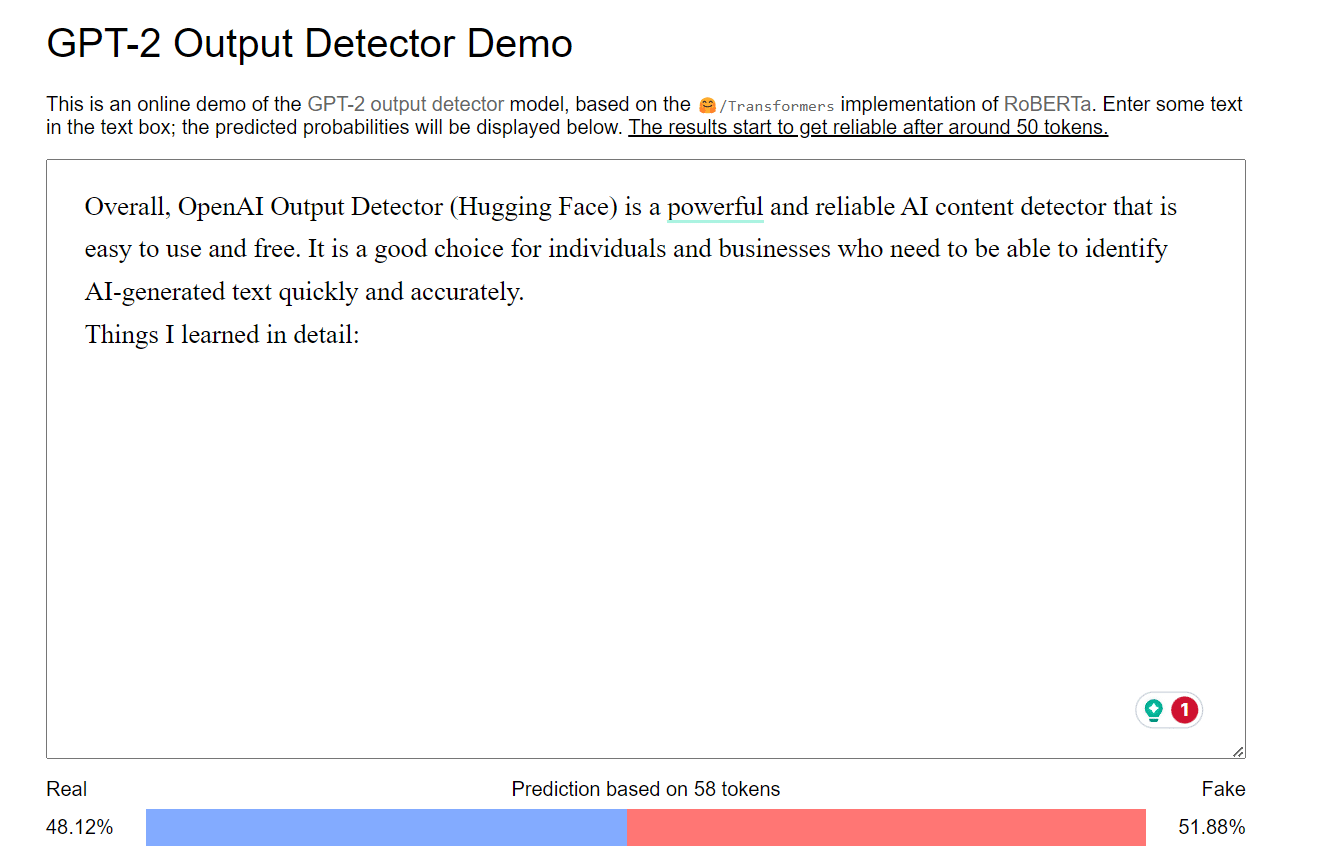
Pros:
- Very easy to use, with a clean and simple interface.
- Free to use.
- Available on Git.
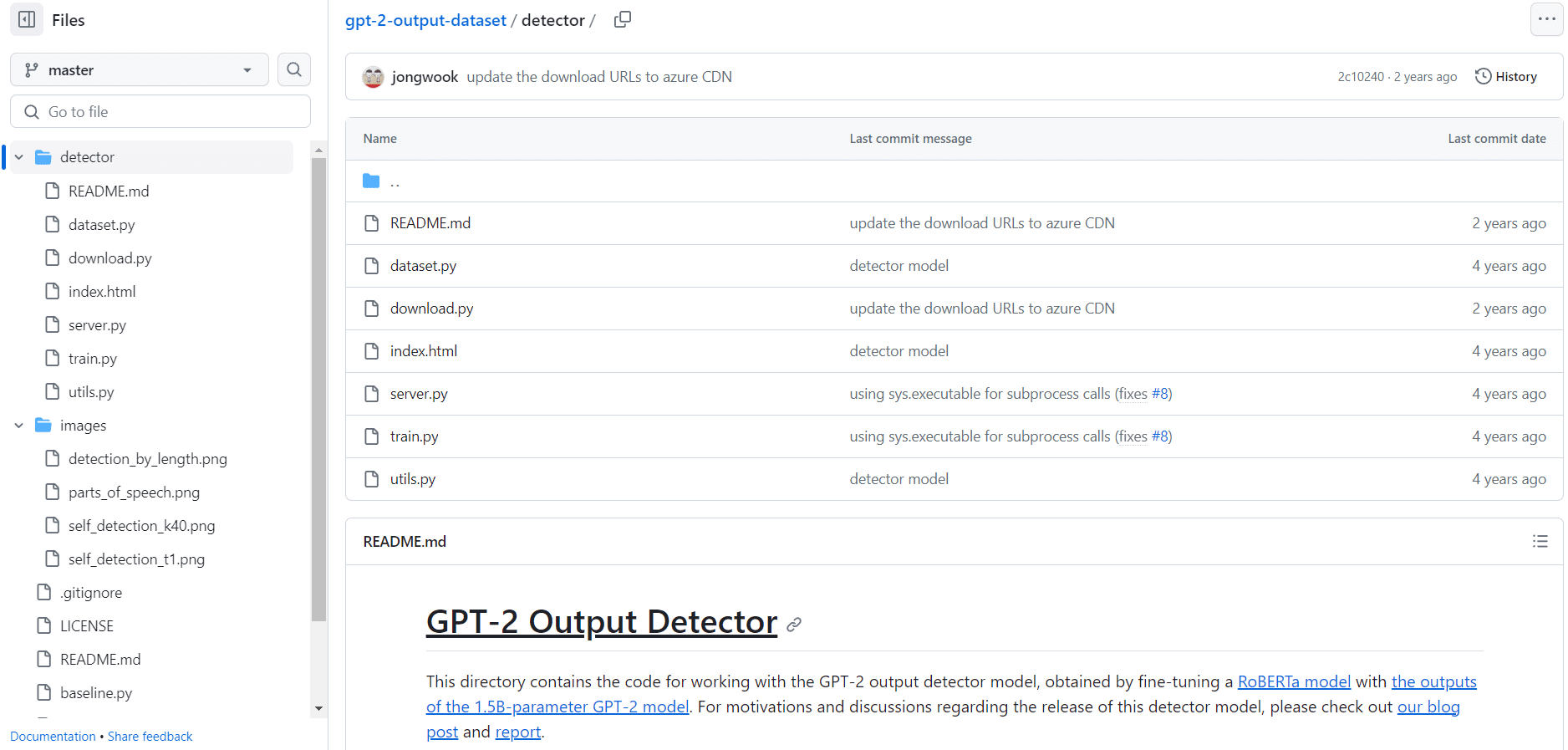
Cons:
- Not very accurate at detecting AI-generated text.
- Does not highlight the text.
- Not as well-known as some other AI content detectors, such discussed above.
- Slow to process large files.
-
Does not offer as many features as some paid AI content detectors.
10. GLTR (Giant Language Model Test Room)
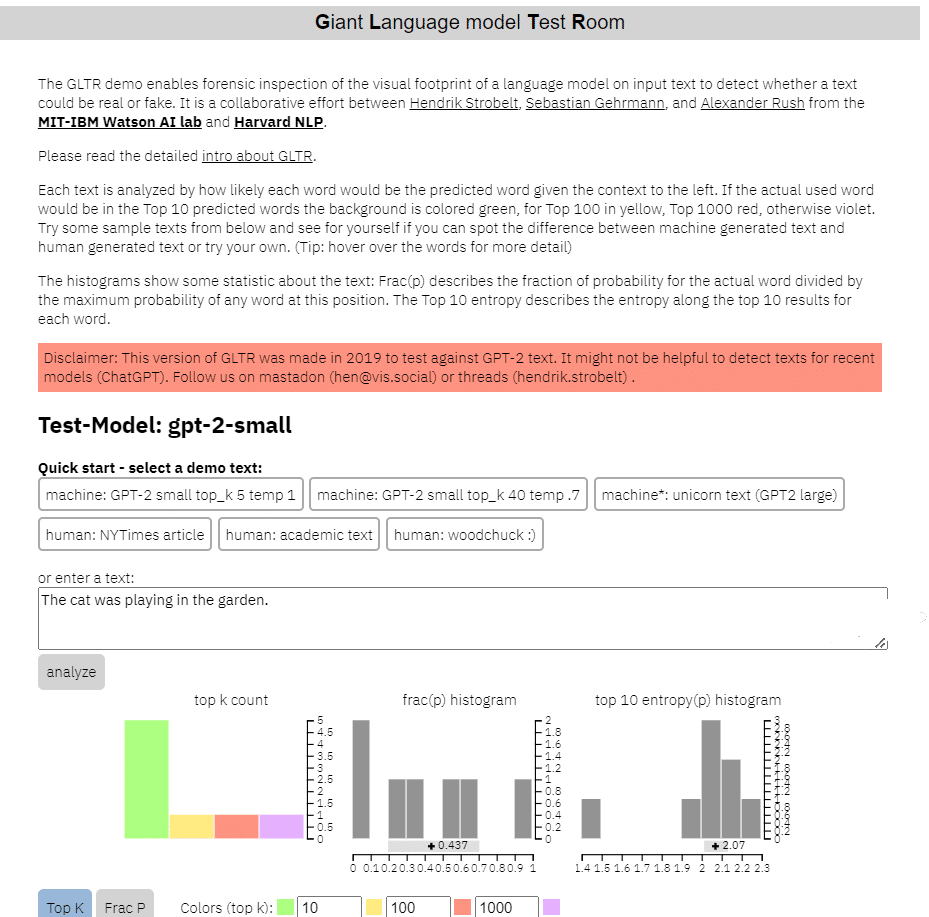
Pros:
- Free to use.
- The GLTR demo enables forensic inspection of the visual footprint of a language model on input text to detect whether a text could be real or fake. It is a collaborative effort between Hendrik Strobelt, Sebastian Gehrmann, and Alexander Rush from the MIT-IBM Watson AI lab and Harvard NLP.
- Provides a visualization of how likely each word in a text is to be predicted by a large language model (LLM).
- Can be used to detect AI-generated text, even when it is mixed with human-written text.
Cons:
- Not as accurate as some paid AI content detectors.
- Not very user friendly as most of the other AI detectors.
- Can be fooled by highly polished AI-generated content.
- Does not provide a detailed explanation of why it believes the content is AI-generated.
GLTR is a free AI content detector, while Winston AI, Originality.ai, Copyleaks, Sapling AI Detector, GPTZero, Writer.com AI Content Detector, OpenAI Output Detector (Hugging Face), and CrossPlag are all free or paid AI content detectors. GLTR is comparable to OpenAI Output Detector (Hugging Face), Kazan SEO, and CrossPlag in terms of accuracy, but it does not offer as many features.
Winston AI, Originality.ai, and Copyleaks are all very accurate AI content detectors. They are also all easy to use and have a variety of features, such as plagiarism detection, grammar checking, and readability analysis.
Sapling AI Detector and GPTZero are also good AI content detectors, but they are not as accurate as Winston AI, Originality.ai, or Copyleaks.
Writer.com AI Content Detector is not as accurate as any of the other AI content detectors on this list.
Overall, the best AI content detector for you will depend on your specific needs and budget. If you are looking for a free AI content detector that is accurate at detecting AI-generated text, then GLTR, OpenAI Output Detector (Hugging Face), Kazan SEO, or CrossPlag is a good option. If you are looking for a paid AI content detector with the highest possible accuracy and a variety of features, then Winston AI, Originality.ai, or Copyleaks is a good option.
Features to Look for in an AI Content Detector
When choosing an AI content detector, there are a few key features to look for:
Accuracy: The most crucial aspect to take into account is the accuracy of an AI content detector. Choose a technology that has undergone independent testing and has been shown to be reliable in identifying AI-generated stuff. It is also important to note that no AI content detector is 100% accurate. It is always a good idea to have a human editor review any content before publication, regardless of the score given by an AI content detector.
Usability: The AI content detector has to be uncomplicated and straightforward to explore and utilize. Additionally, it must work with the kinds of content you need to examine. The type of content (Image, Video, Text or Code) is also a considerable point to ponder while deciding on the AI content detector.
Features: AI content detectors offer a variety of features, such as plagiarism detection, readability analysis, and tone detection. Consider the features that are important to you and choose a tool that offers the parts you need.
Pricing: The cost of AI content detectors might vary. Pick a tool that matches your demands and budget.
Case Studies
Businesses and individuals are using AI content detectors in a variety of ways, including:
- Plagiarism detection: Academic papers, blog posts, and other sorts of writing may be checked for plagiarism using AI content detectors. This can aid in confirming the author has correctly referenced all relevant sources and that the information is original.
- Copyright infringement detection: AI content detectors may also be used to find instances of copyright infringement. This can aid in shielding companies and people from the risks of copyright infringement litigation.
- Misinformation detection: Artificial intelligence-based content detectors may also be used to identify disinformation. This can aid in shielding organizations and people from the damaging effects of disinformation, such as monetary losses and reputational harm.
Here are some real-world examples of AI content detection in action:
- A news organization uses an AI content detector to identify and remove fake news articles from its website.
- A social media company uses an AI content detector to identify and remove harmful content, such as hate speech and violent threats, from its platform.
- A search engine uses an AI content detector to identify and penalize websites that publish spam or low-quality content.
- A business uses an AI content detector to review its marketing materials before publication to ensure that the content is original and plagiarism-free.
- A student uses an AI content detector to review their essay before submitting it to their teacher to ensure that the content is original and plagiarism-free.
These are just a few examples of how AI content detectors are being used in the real world. As AI content detection technology continues to improve, we can expect to see AI content detectors being used in even more ways in the future.
Challenges of AI content detection
One of the challenges in identifying AI content is the ongoing evolution of content produced by AI. The more sophisticated AI systems become, the harder it will be to distinguish between human-generated content and increasingly realistic and demanding stuff. Because of this, it is more difficult for AI content detectors to differentiate between human- and AI-generated content.
Another challenge for AI content identification is the difficulty distinguishing between AI and low-quality content created by humans. An AI content detector may label it as such if a human-generated piece is poorly written or exhibits specific patterns common to AI-generated material.
The Future of AI Content Detection
We may anticipate significant developments in this technology in the upcoming years as AI content detection is a topic that is quickly evolving. AI content detectors will probably get more robust, precise, and effective as AI technology advances.
In a more extensive range of applications, we may anticipate seeing the deployment of AI content detection algorithms. AI content identification, for instance, may be used to shield users against fraud and other online frauds. Online voting and other democratic procedures might be made more secure with AI content detection.
Overall, AI content identification can improve everyone’s experience online, which is safer and more dependable. To unlock the full potential of this technology and ensure it benefits every individual, we must use it with utmost ethical considerations and in the most appropriate manner possible.